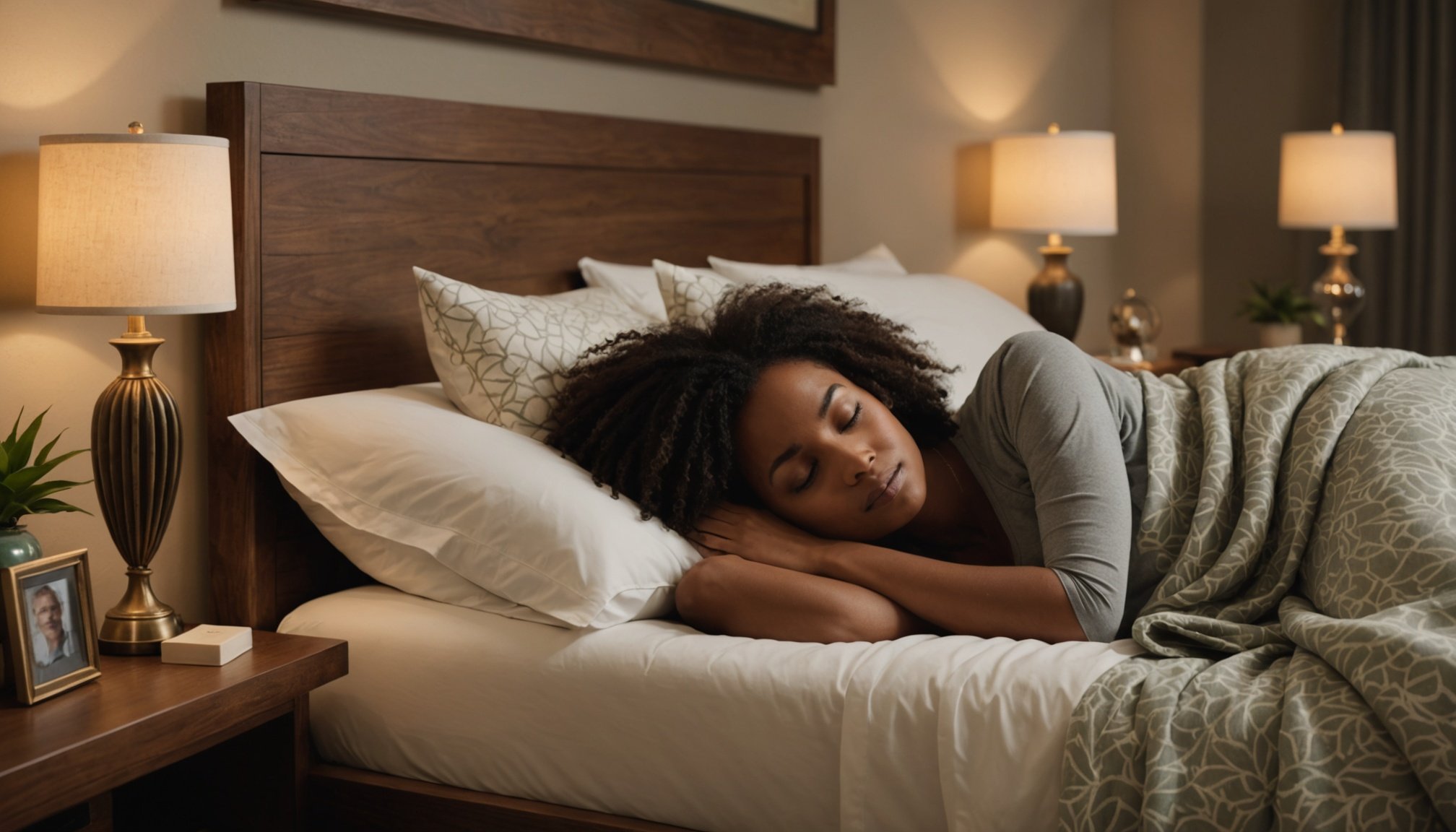Creating a Calming Bedroom Environment
Cultivating a restful space is essential for a good night’s sleep. Your sleep environment plays a vital role in ensuring that your bedroom becomes a personal sanctuary. The first step in achieving this serene atmosphere is through decluttering. By removing unnecessary objects, you free up both physical space and mental clutter, allowing you to truly unwind.
Different elements can transform your bedroom decor into a tranquil escape. Selecting soothing color palettes can significantly impact the mood of the room. Opt for soft blues, muted greens, or gentle earth tones that evoke calmness. These hues not only reflect a sense of peace but also help in lowering stress levels, promoting better rest.
Topic to read : Elevate your everyday happiness: transform your routine with mindfulness techniques for a fulfilling life
Introducing natural elements is another way to enhance your sleep environment. Incorporating items like plants can add life and texture to your decor. Plants not only improve air quality but also provide a sense of connection to nature, which can be incredibly calming. Consider adding a small potted plant or a vase of fresh flowers to elevate your bedroom decor.
Remember, your bedroom decor should resonate with your personal style while prioritising comfort and serenity. These thoughtful choices create a peaceful retreat perfect for rest and relaxation.
This might interest you : Ultimate guide to protecting leather shoes in wet weather: pro maintenance tips you need!
Optimizing Lighting for Sleep
Sleep plays a vital role in overall health, and lighting is a core element in crafting an effective sleep environment. The aim is to create ideal mood lighting that aligns with our natural circadian rhythms. In order to do that, understanding the types of lighting, the application of dimmer switches, and the role of natural light exposure can be instrumental.
Types of Lighting
Different types of lighting can influence sleep quality. Blue-light emitting sources, like electronics, can disrupt melatonin production and interfere with sleep. On the other hand, warm, ambient mood lighting, such as that from soft bulbs, promotes relaxation and aligns with circadian rhythms.
Dimmer Switches and Soft Bulbs
Using dimmer switches and soft bulbs offers flexibility in adjusting light intensity. Lowering the brightness gradually in the evening can signal to the body that it’s time to wind down. This gradual transition allows the circadian rhythms to adjust naturally, enhancing sleep quality.
Benefits of Natural Light Exposure
Exposure to natural light during the day is crucial for a well-regulated sleep cycle. Blackout curtains are effective for blocking artificial light at night, which can disrupt restful sleep. Ensuring exposure to natural light helps regulate the body’s internal clock, substantially supporting circadian rhythms.
Managing Sound Levels
Managing sound levels in your bedroom is vital for creating an environment conducive to relaxation and quality sleep. Noise control plays a crucial role, and one effective method is utilizing white noise machines. These gadgets offer consistent sound frequencies that can drown out disruptive noises. By producing steady background noise, they mask sudden disturbances, allowing for uninterrupted rest.
When designing a bedroom, consider incorporating soundproofing strategies. Simple changes, like thick curtains or rugs, can absorb noise and reduce echo. More advanced options include acoustic panels or insulated windows, which are designed specifically to minimize external sounds. These strategies can help create a quieter sanctuary that’s perfect for relaxation and sleep.
In addition to physical modifications, auditory relaxation can also be achieved through sleep soundscapes. Experiment with playing calming music or soothing nature sounds, such as rain or ocean waves. These sounds can trigger relaxation responses and promote deeper sleep. Incorporating these relaxation techniques as part of a bedtime routine can help ease the transition into sleep.
In summary, by applying various noise control methods such as white noise machines, soundproofing, and relaxation techniques like sleep soundscapes, you can substantially improve the quality of your sleep environment. This holistic approach not only enhances comfort but also supports overall well-being.
Controlling Bedroom Temperature
Achieving the correct sleep temperature is crucial for restful nights. The ideal sleep temperature range is typically between 15.5°C to 19.5°C. Adjusting the indoor climate within this bracket facilitates both comfort levels and quality sleep. This range helps ensure your body can initiate the cooling process essential for deep sleep.
Ideal Sleep Temperature Range
Focusing on this range can significantly improve sleep quality. An environment that’s too hot or too cold can disrupt sleep cycles, leading to restless nights. Maintain room temperature within this specific spectrum to enhance comfort levels throughout the night.
Effective Bedding Materials
Choosing the right bedding is equally crucial. Opt for breathable fabrics such as cotton or bamboo, which efficiently regulate heat. These materials allow air circulation, preventing overheating and maintaining steady comfort. Linen also offers excellent moisture-wicking properties, adding to overall indoor climate management.
Using Fans or Air Conditioning for Climate Control
Fans and air conditioning can be powerful tools for adjusting bedroom climate control. Use fans to distribute air evenly, or set your air conditioner to maintain the desired temperature precisely. Remember, the key lies in keeping the environment comfortable and conducive to sleep, ensuring that your preferred comfort levels are met.
Enhancing Comfort with Bedding Choices
Bedding quality plays a crucial role in achieving a restful night’s sleep. Selecting the right mattress is fundamental, especially considering individual sleep styles. A side-sleeper might benefit from a mattress with softer support, while back-sleepers often find firmer surfaces more accommodating. Understanding mattress selection can dramatically enhance sleep comfort and overall well-being.
In addition to mattresses, the quality of pillows can significantly impact sleep. High-quality pillows offer better neck support, reducing strain and potential discomfort. They provide the necessary support regardless of whether you’re a back or side sleeper, contributing to improved sleep quality. It’s vital to consider pillow material, as hypoallergenic options can benefit those with sensitivities, allowing for a more peaceful rest.
Temperature regulation is another important factor when considering bedding. Cozy essentials like the right bedding materials can enhance sleep by maintaining an optimal sleeping temperature. Natural fibres such as cotton or bamboo are often recommended for their breathability and moisture-wicking properties, ensuring a cool and comfortable night’s sleep. Incorporating these materials into your bedding can prevent overheating and aid in deeper, uninterrupted sleep, catering to a wide range of personal preferences.
The Role of Aromatherapy in Sleep
Aromatherapy has emerged as a widely embraced method to enhance sleep quality. It does so primarily by employing calming scents and essential oils, which are crucial components of effective relaxation techniques. Fostering a peaceful environment is crucial for good sleep, and aromatherapy plays a pivotal role in this.
Popular Essential Oils for Sleep
Certain essential oils are renowned for their sleep-inducing properties. Lavender, chamomile, and cedarwood are among the most popular calming scents. Lavender, known for its soothing fragrance, helps lower heart rate and blood pressure, thoroughly preparing the body for rest. Chamomile is lauded for alleviating stress and tension, making it perfect for nightly use. Cedarwood’s grounding scent promotes a sense of tranquility. These oils can be individually used or blended to optimise benefits.
Incorporating Aromatherapy into Your Routine
To reap the benefits, integrate relaxation techniques using essential oils into your nightly routine. A gentle hands-on approach such as massaging a few drops onto your temples or behind ears can significantly enhance your night. Spritzing a solution of water and oil on pillows is another understated, yet effective, method. Establish this practice consistently for noticeable improvements in sleep quality.
Using Diffusers and Sleep Masks
Diffusers disperse calming scents throughout your room, creating a serene atmosphere. Pairing this with a sleep mask infused with essential oils enhances the sensory experience. This combination not only helps induce sleep faster but also artfully integrates aromatherapy within a soothing bedtime ambiance, inviting restful and uninterrupted sleep.
Establishing a Relaxing Pre-Sleep Routine
Creating a tranquil pre-sleep ritual can significantly enhance the quality of your rest. Implementing a consistent wind-down schedule helps signal to your body that it’s time to relax. Such rituals, like engaging in relaxation techniques, are crucial for good sleep hygiene.
Incorporating relaxation techniques like reading a book or practising gentle stretching can be extremely effective. These activities help transition your mind from the busyness of the day to a more restful state. Reading a physical book, as opposed to using electronic devices, prevents the exposure to blue light, which can interfere with the body’s natural sleep processes.
It’s also essential to minimise exposure to screens and electronics before sleep. The blue light emitted by phones, tablets, and TVs can suppress melatonin production, a hormone responsible for regulating sleep cycles. By avoiding screens at least an hour before bedtime, you can improve the quality of your sleep.
Ensuring you have a relaxing environment also plays a role in sleep hygiene. Keep your bedroom cool and quiet and consider using soft lighting to create a calming atmosphere. Adopting these habits as part of your pre-sleep routine can lead to more restful and rejuvenating sleep.













